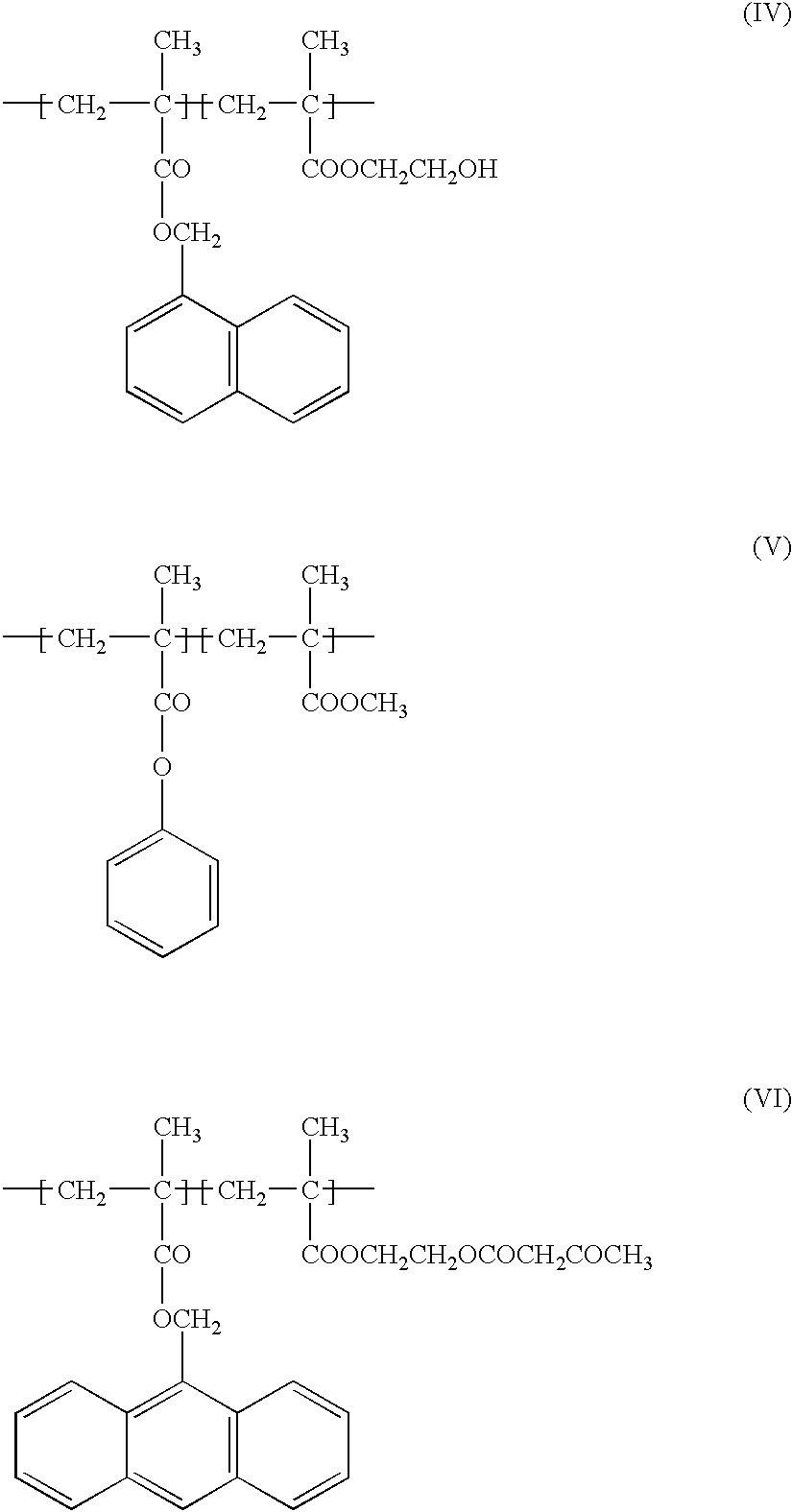Blocked isocyanate compound-containing composition for forming a radiation absorbing coating and anti-reflective coating formed therefrom
- Summary
- Abstract
- Description
- Claims
- Application Information
AI Technical Summary
Benefits of technology
Problems solved by technology
Method used
Image
Examples
example 1
Synthesis of Blocked Isocyanate Group-Containing Polymer 1
[0037]38.3g (0.44 mol) of 2-butanoneoxime was mixed with 550 g of tetrahydrofuran at room temperature to prepare a uniform solution. To this solution was dropwise added 62 g (0.4 mol) of 2-isocyanatoethyl methacrylate under stirring and, after stirring the mixture for 3 hours at room temperature, a solution of 40 g (0.4 mol) of methyl methacrylate in 100 g of tetrahydrofuran and 4.6 g of azobisisobutyronitrile (AIBN, initiator) were added thereto. After stirring the solution for 20 minutes under a nitrogen stream, polymerization was conducted at 65° C. for 7 hours. After completion of the reaction, the reaction solution was cooled to room temperature and subjected to precipitation from hexane. The white powdery product thus produced was filtered out, washed with hexane, and vacuum dried to obtain 110 g of a polymer containing isocyanate groups blocked with 2-butanoneoxime. GPC analysis using tetrahydrofuran as a mobile phase ...
example 2
Synthesis of Blocked Isocyanate-Containing Polymer 2
[0038]38.3g (0.44 mol) of 2-butanoneoxime was mixed with 550 g of tetrahydrofuran at room temperature to prepare a uniform solution. To this solution was dropwise added 62 g (0.4 mol) of 2-isocyanatoethyl methacrylate under stirring and, after stirring the mixture for 3 hours at room temperature, a solution of 70.4 g (0.4 mol) of benzyl methacrylate in 150 g of tetrahydrofuran and 4.6 g of AIBN were added thereto. After stirring the solution for 20 minutes under a nitrogen stream, polymerization was conducted at 65° C. for 8 hours. After completion of the reaction, the reaction solution was cooled to room temperature and subjected to precipitation from hexane. The white powdery product thus produced was filtered out, washed with hexane, and vacuum dried to obtain 120 g of a polymer containing isocyanate groups blocked with 2-butanoneoxime. GPC analysis using tetrahydrofuran as a mobile phase and using polystyrene as a standard subs...
example 3
Synthesis of Blocked Isocyanate-Containing Polymer 3
[0039]To a solution obtained by dissolving 55.5g of 2-butanoneoxime in 145 g of propylene glycol methyl ether acetate (PGMEA) at room temperature was added 50 g of a polycondensation resin of phenyldiisocyanate and formaldehyde marketed by Aldrich Co., followed by stirring for longer than 10 hours to obtain a solution of a polymer wherein isocyanate groups were blocked. PGMEA was added to this reaction solution in such amount that concentration of said polycondensation resin became 10 wt %. This solution was used below as a solution for preparing the composition for forming an anti-reflective coating.
PUM
| Property | Measurement | Unit |
|---|---|---|
| Temperature | aaaaa | aaaaa |
| Temperature | aaaaa | aaaaa |
| Temperature | aaaaa | aaaaa |
Abstract
Description
Claims
Application Information
 Login to View More
Login to View More - R&D
- Intellectual Property
- Life Sciences
- Materials
- Tech Scout
- Unparalleled Data Quality
- Higher Quality Content
- 60% Fewer Hallucinations
Browse by: Latest US Patents, China's latest patents, Technical Efficacy Thesaurus, Application Domain, Technology Topic, Popular Technical Reports.
© 2025 PatSnap. All rights reserved.Legal|Privacy policy|Modern Slavery Act Transparency Statement|Sitemap|About US| Contact US: help@patsnap.com



